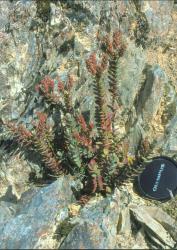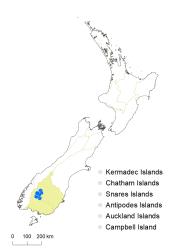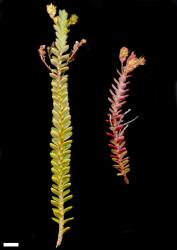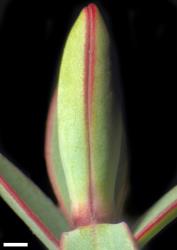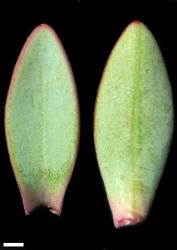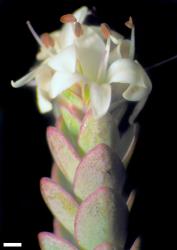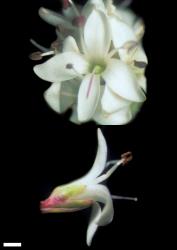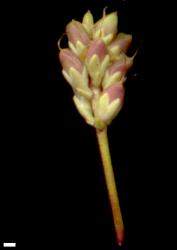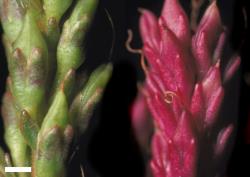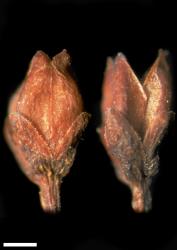- ≡ Hebe biggarii (Cockayne) Cockayne, Trans. New Zealand Inst. 60: 469 (1929)
Small, bushy shrub to 0.5 m tall. Stems decumbent to erect; glabrous or sparsely eglandular-puberulent; hairs bifarious. Leaf bud distinct, its outer leaves fully grown, appressed at margins; sinus absent. Leaves opposite-decussate to weakly sub-distichous, erecto-patent to spreading; lamina coriaceous, narrowly to broadly elliptic or rhomboid, 5–20 mm long, 2–10 mm wide, dull and glaucous above and beneath or sometimes red, especially beneath; midrib obscure or faint; surfaces glabrous; margin glabrous or a few minute hairs at base, entire; apex bluntly acute to rounded; base cuneate; petiole absent. Inflorescence a lateral raceme, 20–50 mm long; flowers crowded, 8–25, all bisexual; bracts alternate, linear to narrowly deltoid, ≤ pedicels; pedicels erecto-patent, 1–3 mm long, sparsely eglandular-puberulent all around or sometimes glabrous. Calyx lobes 4, rarely 5 (5th lobe small, posterior), sub-acute to acute, 1.2–2.0 mm long, sub-equal, mixed glandular- and eglandular-ciliolate. Corolla 5.5–8.0 mm diameter, tube white, 1.5–2.0 mm long, = or slightly > calyx, glabrous; lobes 4, white, spreading to recurved, sub-equal, elliptic or narrowly elliptic, 3–4 mm long, obtuse to rounded; nectar guides absent. Stamen filaments white, 3–4 mm long; anthers magenta. Style glabrous, 3.5–5.0 mm long. Capsules latiseptate, acute to acuminate, rarely obtuse, glabrous, 3–4 mm long, 2–3 mm at widest point. Seeds ellipsoid to oblong or irregular, flattened, smooth, straw-yellow to pale brown, 0.9–1.3 mm long.
Veronica biggarii plants are usually small, and the stems often don’t branch much. The glaucous or reddish leaves are elliptic to almost rhomboid. The hairs are sparse, if present at all, and very short (and bifarious) on stems, margins of leaves at the base, inflorescences, and calyx margins (where they include short, glandular hairs mixed with eglandular). Among similar small-leaved glaucous hebes, V. amplexicaulis plants can be distinguished by having amplexicaul leaves, long hairs, and sessile flowers; V. gibbsii by long fringing leaf margin hairs; while V. pinguifolia, V. buchananii, V. pimeleoides, and V. gibbsii all have sessile or very shortly pedicellate flowers, the lowermost opposite, and all have hairy capsules (except for some plants of V. pimeleoides, which is characterised by mauve to purple flowers).
Many plants display intense red pigmentation in the leaves (especially the margins) and inflorescences (including developing capsules), but this may vary among individuals in populations. Many other hebes have red leaf margins (Hughes et al. 2010), but V. biggarii plants are often conspicuously very red.
South Island: Otago, Southland (Eyre Mountains, Thomson Mountains, Mid Dome).
Rock outcrops and cliffs, also in open places in snow tussock grassland. Recorded elevations range from 720 to 1448 m.
Flowers: October–January (some seen as late as June); fruits: November–May.
2n = 40 (see Bayly & Kellow 2006, as Hebe biggarii).
Veronica biggarii is classified in V. subg. Pseudoveronica sect. Hebe and the informal group “Subcarnosae” (Albach & Meudt 2010; Bayly & Kellow 2006).



